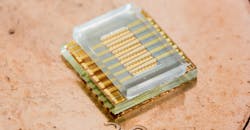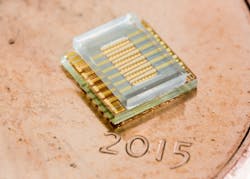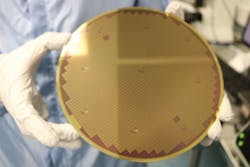MEMS Switches Shrink with Glass Substrates
Glass is a filler for many circuit-board materials. It’s also an excellent substrate material, as Menlo Micro has shown by fabricating miniature, high-performance microelectromechanical-systems (MEMS) switches on glass wafers.
By teaming with glass-master Corning and applying its own through-glass-via (TGV) technology and patented digital-micro-switch (DMS) technology, Menlo Micro is on a clear path to making RF/microwave switches even smaller—without compromising key performance parameters like power-handling capability. The recently announced model MM3100 MEMS switch is one example of what can be done with MEMS technology built on a glass foundation.
1. Model MM3100 is a six-channel, single-pole, single-throw (SPST) MEMS switch capable of handling 25-W CW power and 200-W peak (pulsed) power per channel from dc to 3 GHz. It’s shown here without the BGA package, in die form.
The MM3100 is a six-channel, single-pole, single-throw (SPST) MEMS switch for applications from dc to 3 GHz (Fig. 1). As Corning continues to refine its glass-wafer production processes, to enable glass substrates as large as 8 in. diameter with impeccably smooth surfaces, it’s the quality of those surfaces and dielectric consistency of that glass material that enables thousands of MEMS devices (e.g., the MM3100) to be produced from a single wafer (Fig. 2). The high quality of the metal-on-glass interfaces results in consistently low-loss transmission lines on the substrates and highly repeatable performance from the devices fabricated on the glass wafers.
The high-performance levels possible from glass-substrate-fabricated components is evident with the model MM3100 switch. Operating from dc to 3 GHz, it features low insertion loss of 0.3 dB at 3 GHz (and less at lower frequencies) when the switch is in the “on” position. It also achieves good isolation between inputs and the output port with isolation of typically 25 dB (and more at lower frequencies) when the switch is in the “off” position.
The six-channel switch is housed in a hermetic BGA package measuring just 6.0 × 6.0 × 1.3 mm. Despite the small size, over the full frequency range it can handle 25-W CW input power per channel and as much as 200-W peak (pulsed) input power per channel. Operating temperature range is −40 to +85°C
Lest circuit and system integrators think of glass as being in any way frail, they need only look at the long-term reliability of these glass-based MEMS switches. They are rated for 3 billion switching cycles without failure or performance degradation even when used in harsh military environments. Switches like the MM3100 are well-suited for multiple-signal control in radar and communications applications such as for signal beamforming in multiple-input, multiple-output (MIMO) antenna arrays. The MM3100 is controlled by means of a Serial Peripheral Interface (SPI) and includes an integrated switch driver; SPI control is via an external +5-V dc logic supply and +77-V dc bias source.
2. This glass-based 8-in.-diameter wafer from Corning features the TGV technology that enables the miniaturization of Menlo Micro’s RF MEMS switches.
The MM3100 exhibits many characteristics favorable to both analog and digital circuit designs because of the high-quality glass dielectric substrates and Menlo’s proprietary high-conductivity metal alloy transmission lines. For example, in addition to its excellent EM signal conductivity and low insertion loss in the “on” state, the switch is virtually invisible to a circuit when in the “off” state, with its high isolation and low off-state (parasitic) capacitance of less than 200 fF. It’s quite rugged and can withstand voltages as high as 200 V dc when in the “off” state. The switch also exhibits very low “on” state resistance of typically less than 0.5 Ω, enabling it to maintain low loss even under high-current conditions.
Of course, the MM3100 is just the start of what can be done with this combination of MEMS technology and semiconductor-quality glass wafers. However, its combination of small size, performance, and reliability are sure to reach higher frequencies in the future to serve many other commercial and military specifiers.
Menlo Microsystems Inc., 49 Discovery, Ste. 150, Irvine, CA 92618; 1-(949) 771-0277.
About the Author
Jack Browne
Technical Contributor
Jack Browne, Technical Contributor, has worked in technical publishing for over 30 years. He managed the content and production of three technical journals while at the American Institute of Physics, including Medical Physics and the Journal of Vacuum Science & Technology. He has been a Publisher and Editor for Penton Media, started the firm’s Wireless Symposium & Exhibition trade show in 1993, and currently serves as Technical Contributor for that company's Microwaves & RF magazine. Browne, who holds a BS in Mathematics from City College of New York and BA degrees in English and Philosophy from Fordham University, is a member of the IEEE.



